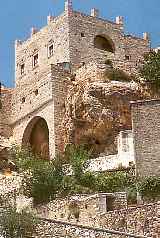|
|
Naxos Island
 Being the
largest island in the Cyclades, Naxos has a commodity many of
its more illustrious neighbours lack - space. Barren,
ashen-grey mountains, lush valleys of citrus and olive groves,
pastel-coloured coastal plains and wide stretches of empty,
golden sand all but envelop the tiny, quaint villages that lie
dotted amongst this rich panoply. Being the
largest island in the Cyclades, Naxos has a commodity many of
its more illustrious neighbours lack - space. Barren,
ashen-grey mountains, lush valleys of citrus and olive groves,
pastel-coloured coastal plains and wide stretches of empty,
golden sand all but envelop the tiny, quaint villages that lie
dotted amongst this rich panoply.
Naxos Town
differs from nearly all its brother and sister towns in the
Cyclades by not being eye-catchingly attractive. What it lacks
in tweeness it more than makes up for in character with the
bustle of an indigenous, year-round population, the perfect
complement to wonderful old buildings and a plethora of shops,
tavernas and cafes.
By contrast in the extreme, Kastraki is
situated on semi-virginal coastline south of Naxos Town. This
totally unspoilt part of Naxos has an embarrassing wealth of
empty beaches and very little else except excellent holiday
accommodation. Finally, the fledging "beach resort"
of Agios Prokopios has one of the very best sandy beaches on
the island with watersports, tavernas and cafes the simple
order of the day.
 History:
Naxos is the largest island of the Cyclades.
It lies between Mykonos, Amorgos
and Paros. A tall mountain line
crosses the whole surface of the island from its southern to
its northernmost edge. Its soil
is fertile. According to mythology, Naxos was the island of
the god Dionysus us and Ariadne who helped Theseus to kill the
Minotaur. It is mentioned that in this island Zeus grew up in
a cave of the highest mountain that is named Zas.
In the ancient time it was named Dia. History:
Naxos is the largest island of the Cyclades.
It lies between Mykonos, Amorgos
and Paros. A tall mountain line
crosses the whole surface of the island from its southern to
its northernmost edge. Its soil
is fertile. According to mythology, Naxos was the island of
the god Dionysus us and Ariadne who helped Theseus to kill the
Minotaur. It is mentioned that in this island Zeus grew up in
a cave of the highest mountain that is named Zas.
In the ancient time it was named Dia.
Around 1.000 BC Ion emigrants
settled in the island. The name Naxos derives from the name of
its ruler Naxos and it was known as Naxia
in the Middle Age. The island suffered by many
raids from the pirates, especially the Saracens. This is
the reason why its inhabitants settled in the central parts of
the island.
Sightseeing's:
The Archaeological Museum that is housed in the old merchants'
school of the Jesuits, has notable finds. One of the most
important sightseeing's stands to the west of the village
Apollonas' it is a giant bearded
Couros,dedicated to the god
Apollo, a unique specimen
of archaic plastics of the 7the century BC. Naxos is
considered one of the centers of the development of the
archaic plastic art.
|
>> Cyclades Islands : Amorgos, Anafi,
Andros, Antiparos,
Delos, Folegandros,
Ios, Kea,
Kimolos, Kithnos,
Koufonisia, Milos,
Mykonos, Naxos,
Paros, Santorini,
Serifos, Sifnos,
Sikinos, Syros,
Tinos.
|
|